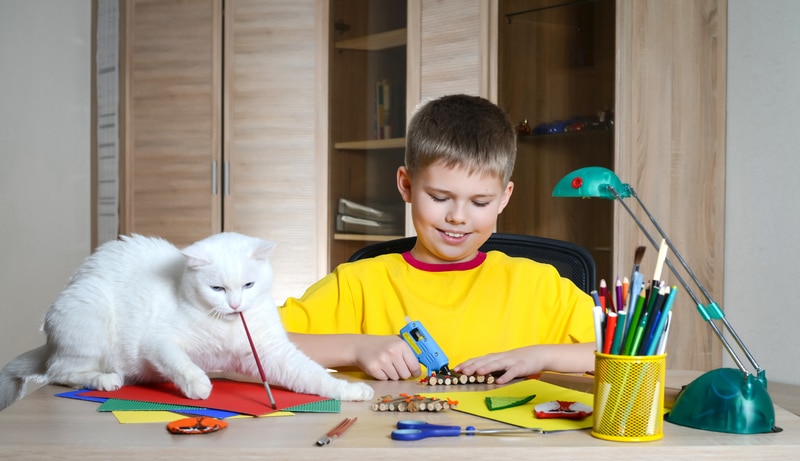Moving house and settling a cat into a new home can be stressful, not only for you but for your feline companion as well. Cats are territorial animals, creatures of habit, who may find the changes and chaos of a move distressing. As cat parents, our role is to ensure their transition from the old house to the new one is as smooth and stress-free as possible. This article guides you through the whole process from pre-move preparations, to moving day logistics, to helping your cat adjust to the new environment.
Before Moving House With Your Pet
Updating the Cat’s Information
Ensure that your cat’s identification tags and microchip information are up-to-date with your new address and contact details. It’s vital in case they get lost during the transition. This step is crucial as it increases the likelihood of being reunited with your pet if they get lost in the new neighbourhood.
Creating a Safe Haven
Designate a quiet room in your current house where your cat can retreat to when the packing activity increases. This room should contain all the cat’s essentials like food, water, a litter box, and their favourite toys or bed. A familiar space will help reduce stress and anxiety in your cat during the packing period.
Keep the Same Routine While You Pack
As you prepare for the move, try to maintain your cat’s regular routine as much as possible. This includes feeding times, play times, and any other routines your cat is used to. Abrupt changes can be distressing to cats, so keeping the normality intact can help your cat adjust better.
Use of Pheromone Diffuser
Consider using a feline pheromone diffuser in the room designated as the cat’s safe haven. Pheromones can help to reduce stress and anxiety in your cat. The diffuser disperses a scent that mimics the feline facial pheromone, making your cat feel more secure and relaxed.
Moving Day
On the day of the move, confine your cat to the safe haven with their essentials. This prevents them from getting in the way, getting hurt, or even running out of the house due to the hustle and bustle of moving.
Arriving at Your New Home
Put Your Cat in a Safe Area
Upon arrival at your new home, set up a similar safe haven for your cat. This will be their sanctuary until they are comfortable enough to explore the rest of the house.
Make Sure the Whole House is Escape-Proof
Before you let your cat roam around, check every nook and cranny of the house. Make sure all windows, doors, and other exit points are secure, and there’s no place for the cat to hide where you can’t reach them.
Keep Routines the Same
Maintain your cat’s feeding, playtime, and other routines in the new house. This familiar pattern will provide comfort and a sense of stability during this transition.
Unpack Their Toys and Enrichments
Unpack your cat’s favorite toys, beds, or scratching posts as soon as possible. Familiar items with your cat’s scent can make them feel more secure and at home in the new environment.
Scent-swapping
Scent is very important to cats. Rubbing a soft cloth on your cat and then on new furniture items can help spread their scent around and make the environment feel more familiar to them.
Register with Vet
Find and register with a local vet as soon as you’ve moved. This ensures you’re prepared in case of any emergencies or health issues with your cat.
Keep the Cat Indoors
Keep your cat indoors for at least a few weeks to allow them time to acclimate to their new surroundings. This can prevent them from trying to return to your previous home.
Helping Your Cat Settle In

How to introduce a cat to a new house when moving?
Start by letting your cat explore one room at a time. Supervise these explorations to ensure safety. Don’t force your cat to explore; let them take their time.
How long does it take a cat to adjust to a new home?
It varies greatly from cat to cat. Some might adjust within a week, while others may take several weeks or even months. Be patient and provide comfort and stability for them during this period.
Signs your new cat is adjusting
Indicators of a cat’s successful adjustment include regular eating and bathroom habits, exploration of the house, and normal play and sleeping patterns. They may start engaging in their usual activities, like scratching, playing, or seeking attention from you.
Outdoor Access and Safety
Letting cats out for the first time after moving
Before letting your cat outside for the first time, make sure they are completely comfortable in their new indoor environment. Start by taking them out for short, supervised periods, gradually increasing the time as they become more comfortable.
Moving House With a Cat Easily Using the Help of Mover
Professional movers who are experienced in pet relocation can greatly assist in moving house with a cat. They can provide specialized carriers, pet-friendly travel options, and a host of other services to make the move easier for both you and your feline companion.
The Aftermath of the Move
It’s important to realize that some cats may exhibit behavioral changes after a move. This can include altered sleeping patterns, changes in appetite, or even uncharacteristic aggression or fearfulness. These behaviors can be a sign of stress or anxiety, so it’s important to keep an eye on your pet and consult with a vet if these behaviors persist.
Post-move Play and Interaction
Make an extra effort to interact with your cat and engage them in play. Not only will this help to establish their new territory as a positive and fun place, but it will also help to establish a new routine. This can be very comforting for cats, particularly as they adjust to a new environment.
Post-move Monitoring
Keep a close eye on your cat in the days and weeks following the move. Look out for signs of illness or distress, including changes in eating or toileting habits, signs of weight loss, or unusual behaviors.
It’s also important to watch for any signs that your cat may be trying to return to your old home, particularly if you’ve moved within the same area. Cats have been known to try and make their way back to their previous territory, and this can be very dangerous, particularly in urban areas with busy roads.
Emotional Support
While cats are known for their independence, they can also be very sensitive to changes in their environment and routines. Providing emotional support during this time can be key to helping your cat adjust.
This can be as simple as spending some extra time each day cuddling with your cat, providing them with a comfortable and safe space to sleep, and speaking to them in a calm, reassuring voice. Remember, your cat will pick up on your emotions, so try to remain calm and positive throughout this transition.
In Conclusion
Moving house with a cat can be challenging, but with careful planning and preparation, you can help to ensure that your feline friend is able to adjust to their new home as smoothly and quickly as possible.
Remember, each cat is unique, and will react to moving in their own way. Some cats may take longer than others to adjust to a new environment, so it’s important to be patient and understanding during this time.
By taking the time to plan ahead, taking measures to reduce stress and anxiety during the move, and providing support and care for your cat post-move, you can help to ensure a successful transition for your furry friend.
Remember, your love and patience are the most critical factors in helping your cat adjust to their new home. Providing these will ensure that your cat feels safe and secure, and can help to establish their new house as their home.

